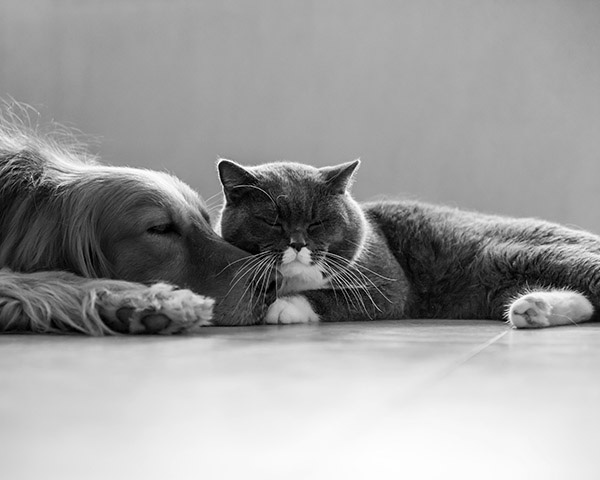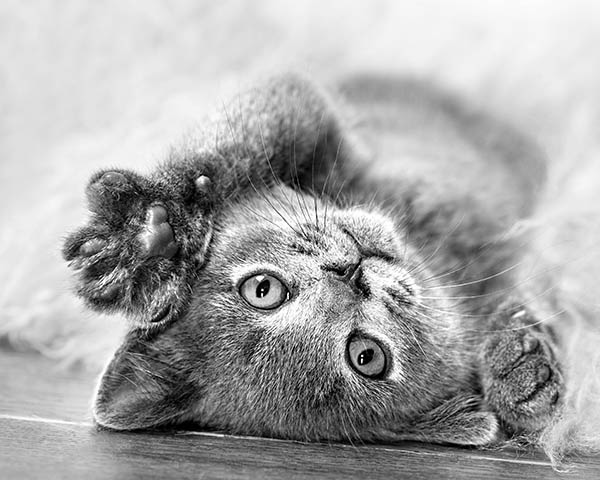How to tell if your cat is too fat?
Most healthy domesticated adult cats will weigh in at around 3.6 to 4.5kg, according to Cats Protection, but there’s no one-size-fits-all. An unhealthy weight for your cat will vary depending on various factors, including their age, breed and gender.
A good way to tell if you have an overweight cat is by feeling them and checking their shape. If your cat is a healthy weight, you’ll be able to feel their ribs, spine and hip bones, without them being too prominent (which could be a sign your cat is underweight).
You can also gently squeeze the base of their tail – there shouldn’t be any fat build-up. Your cat should have a smooth, tucked-in waist rather than a round belly, and the abdominal fat pad should only just be visible. Look at them from the side and from above to get a better idea of their exact shape.
Signs of obesity in cats
You may notice other factors that could indicate your cat is on the road to obesity. These include:
- Increased difficulty jumping up on furniture or going up stairs
- Being less active or showing unwillingness to move around or get up
- A coat that more often looks messy, dirty or unkempt
- A collar that keeps getting tighter
- Less frequent bowel movements
- More passing of gas
If you notice any of these signs, you might want to start regularly checking your cat’s size, shape and weight to help prevent cat obesity.
Why is my cat overweight?
The most common reason for a cat to be overweight is simply that they’re consuming more calories than they’re burning off – just like humans. If you can get them to eat less and move more (easier said than done!), the problem will fix itself.
Indoor cats or those with restricted time outdoors are more prone to becoming overweight, as they most likely won’t get as much exercise as outdoor cats. Middle-aged cats (around eight to 12 years) are also more likely to put on weight.
However, there are two other reasons why a cat might be overweight. If you have an unneutered female, they could be gaining weight because they are pregnant. It’s also possible that there could be an underlying medical cause for sudden weight gain, although this is rare.
Older cats or those with conditions such as arthritis, lung disease or heart disease may naturally slow down, which means they need to consume fewer calories to maintain a healthy weight.
Health risks for overweight cats
When a cat is overweight or obese, it’s not just about how they look. There are multiple potential health risks that overweight cats can be more susceptible to. These include:
Diabetes
Diabetes is common in cats and is thought to affect around one in 100 felines. Cat obesity is one of the highest risk factors for the development of diabetes, along with a lack of physical activity. Males are diagnosed more often than females, and certain breeds, such as Burmese cats, are also higher risk.
Liver disease
Fatty Liver disease (scientifically known as hepatic lipidosis) occurs most often in middle-aged cats who are, or were, overweight and have stopped eating. This causes a rapid build-up of fat in the liver, which in turn causes the cells to stop functioning properly.
The good news is that around 90% of cases are treatable, so see your vet immediately if your cat stops eating for more than a day or two.
Breathing problems
Excess body fat can cause pressure around the lungs, which can lead to your cat struggling to breathe. Flat-faced breeds such as Persian cats are at higher risk of obesity-related breathing difficulties.
Cancer
While there are only limited studies on the relationship between obesity and cancer in cats, some reports do show an increased risk for certain types of cancer. In both humans and cats, adipose tissue releases various hormones and molecules called adipokines. These have been shown to increase the risk of certain types of cancer in humans, so it stands to reason that obesity in cats could also increase their risk of developing those cancers.
Bladder problems
Cats of all ages and sizes can develop urinary tract problems. However, these are most often diagnosed in cats that are middle-aged and overweight. Obese cats are more likely to experience cystitis and other urinary infections, according to Cats Protection.
Arthritis
Between 70% and 90% of all cats will develop arthritis as they get older and reach around 12 years of age. While being overweight doesn’t cause arthritis in cats, carrying that weight puts additional strain on joints that are already inflamed and painful. The first step to help ease that strain is to slim down an overweight cat.
Cat weight loss tips
Just as with humans, the way to help an overweight cat is often with lifestyle changes. More exercise and less food, or less fatty food, is usually the solution. However, if you have any concerns, you should always speak to your vet.
Diet
Specially designed calorie-controlled foods are a good way to ensure your overweight cat gets all the nutrition they need while reducing their calorie intake. These typically contain fewer fats and more proteins to promote a feeling of fullness. You may also be advised to switch from a dry food diet to canned or wet food to achieve nutrient goals.
In some cases, a metabolic control prescription diet may be recommended, as this helps your overweight cat burn fat for energy, as opposed to the glucose in carbohydrates. Remember to transition to any new diet slowly over a week to 10 days to avoid gastrointestinal upsets.
Exercise
As well as changing their diet, overweight cats also need encouragement to exercise more. This can be any form of movement, and you can make it fun for both of you. Try to encourage your cat to play with you at home, feed them on an elevated surface to promote jumping, use puzzle feeders, or even get them a harness and take them for a daily leash walk. The more they move, the more calories they will burn.
Speak to your vet
Speaking to your vet is essential if you have an overweight cat. They will be able to rule out any potential underlying health issues that could be causing your cat to gain weight. Your vet can also develop a calorie-controlled diet that meets their nutritional needs. They will assess your cat’s weight, lifestyle and any other factors, and suggest a recommended daily calorie intake. They will also be able to suggest specific food and healthy treats, as well as monitor their progress over time.
Cat insurance for overweight cats
When it comes to our four-legged friends, you can’t put a price on peace of mind. Taking out Sainsbury’s Bank Pet Insurance can help you feel assured that, should any health issues arise, you may have help covering the cost.
Frequently asked questions
Are some cats meant to be overweight?
No, all breeds of cat can become overweight or obese, but there are no breeds where this is healthy for them. Being overweight can pose significant risks to your cat’s health, so it’s essential to offer them a healthy diet and monitor their weight.
How long will an overweight cat live?
An overweight cat will typically only live for five to 10 years, compared to a lifespan of 11.7 years on average for a healthy cat, according to Cats Protection. Monitoring weight and discouraging weight gain is therefore essential throughout your cat’s life.
Is insurance more if my cat is overweight?
Your pet insurance may have higher premiums and or a higher excess if your cat is overweight, as this may count as a pre-existing condition. You may also find it harder to get the cover you need if your cat is already obese. Take out insurance before any issues arise for peace of mind and monitor your cat’s weight from the day you get them.

Browse our guides
Choose from our list of helpful guides and information

Cat breed guides
How to care for your cat, common health problems and more

Explore dog breeds
Find out how to keep your dog healthy and happy
Important Information
Sainsbury's Bank plc, Registered Office, 33 Charterhouse Street, London, EC1M 6HA (registered in England and Wales, no 3279730) is authorised by the Prudential Regulation Authority and regulated by the Financial Conduct Authority and the Prudential Regulation Authority (register no. 184514).
Sainsbury's Supermarkets Ltd is an appointed representative of Sainsbury's Bank plc. Sainsbury's Bank plc acts as an introducer to Pinnacle Insurance Ltd who is authorised by the Prudential Regulation Authority and regulated by the Financial Conduct Authority and the Prudential Regulation Authority (register number 110866). Registered office: 4th Floor, Limelight, Elstree Way, Borehamwood, Hertfordshire, WD6 1JH. Sainsbury’s Bank Pet Insurance is arranged, administered and underwritten by Pinnacle Insurance Ltd. Sainsbury's Bank plc and Pinnacle Insurance Ltd are not part of the same corporate group.
We do not provide personal recommendations to customers.
